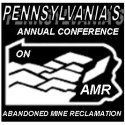By Anne Daymut, Watershed Coordinator adapted by Robert E. Hughes, EPCAMR Executive Director
Now in our fifth year, WPCAMR and EPCAMR have partnered with the Anthracite Region Independent Power Producer’s Association (ARIPPA) to offer a competitive award to watershed organizations working on Abandoned Mine Land (AML) and/or Abandoned Mine Drainage (AMD) remediation projects. Grants at a maximum of $2,500 will be awarded to at least one eligible environmental organization, non-profit, or Conservation District in the Anthracite Region and one eligible environmental organization or Conservation District in the Bituminous Region in the Commonwealth of Pennsylvania actively working on AML/AMD issues. Grant proposals should be for on-the-ground AML/AMD construction projects with a completion date between August 2013 and August 2015. Proposals are due July 14th. The amount granted is dependent upon demonstrated need. Applying organizations must support the mission of ARIPPA, including the removal and conversion of waste coal into alternative energy and the beneficial use of CFB ash for AML/AMD reclamation.
In the past four years, the ARIPPA Award has funded these projects approved by the Coalitions:
- Clearfield Creek Watershed Association (2010): $8,000 for Swank 13 AMD Passive Treatment
- Evergreen Conservancy (2010): $2,000 for Alternative Energy development at Tanoma Wetlands
- Earth Conservancy (2010): $460 to replace informational signage on the Mocanaqua Loop Trail developed on abandoned mine lands.
- Schuykill Headwaters Association (2010): $4,770 to repair the Glendower Breech which will return a stream back to its original channel avoiding contact with coal sediment.
- Eastern Middle Anthracite Region Recovery, Inc. (2010): $4,770 for construction of a raw water intake on the Audenreid Treatment System to increase flow to the micro-hydro turbines.
- Blackleggs Creek Watershed Association (2011): $2,500 for the construction of a concrete pad for a lime dosing silo in the Bear Run Treatment complex.
- Stream Restoration Incorporated (2011): $2,500 for project costs associated with removing waste coal refuse to be used in energy production and the construction of an AMD treatment system.
- Schuylkill Headwaters Association (2011): $3,000 for the Wagner Run Restoration project to keep water in the stream channel, reducing the volume of the Pine Knot AMD discharge.
- Huber Breaker Preservation Society (2011): $1,000 for the Huber Memorial Park Pedestrian Access Gate project to place a gate in a wrought iron fence surrounding the property.
- Eastern Middle Anthracite Region Recovery, Inc (2011): $1,000 for the Audenreid Micro-Hydro AMD Treatment System Raw Water Intake project to provide reliable flow to the system.
- Sewickley Creek Watershed Association (2012): $2,500 for Iron Sludge Recovery in the Marchand AMD Treatment System.
- Chestnut Ridge Chapter of Trout Unlimited (2012): $2,500 for lime dosing.
- Babb Creek Watershed Association (2012): $1,000 offset cost of micro-hydroelectric turbines that utilize 2 billion gal/day of the Antrim AMD to generate electricity.
- Eastern Middle Anthracite Region Recovery, Inc (2012): $1,000 for refurbishment of hydroelectric components on the Audenried AMD Treatment System.
- Loyalsock Creek Watershed Association (2012): $2,500 to purchase and apply limestone to continue treatment of a large AMD seep at WALA Lake.
- Shamokin Creek Restoration Alliance (2012): $500 to restore roadway, remove silt from pond 2, block entrances, and install signs at Carbon Run Site 42 AMD Treatment System.
- Allegheny Valley Land Trust (2013): for construction of a system to collect sediment from a spoil pile along the Allegheny River
- Evergreen Conservancy (2013): to purchase and install a new water turbine at Tanoma Wetlands, a passive mine drainage treatment system at the headwaters of Crooked Creek, a tributary of the Allegheny River. Combined with a wind turbine and solar panels installed previously, the system will be aerated 24/7.
- Luzerne Conservation District (2013): removal of heavy sedimentation and woody debris dams within the tributary and repair and restore severely eroded streambanks and stormwater outlets flowing into the stream
- Mehoopany Creek Watershed Association (2013): 50 Tons of limestone sand will be applied to the South Branch of Mehoopany Creek to increase the pH levels in the stream to improve the fishery habitat and water quality in the Mehoopany Creek watershed historically impaired by acidity
- Plymouth Historical Society (2013): cleanup of illegally dumped garbage at the historic Avondale Mine Disaster Site where EPCAMR has completed several historic preservation projects in the past, located in Plymouth Township, Luzerne County, PA
- Lackawanna River Corridor Association (2013): a real estate appraisal on the value of abandoned mine lands that are being proposed to be acquired by their partner, the Lackawanna Valley Conservancy, in an effort to secure the property to be used for future AMD Treatment of the Old Forge AMD Borehole, Old Forge Borough, Luzerne and Lackawanna Counties, PA
Celebrating its 25th Anniversary, ARIPPA is a non-profit trade association based in Camp Hill PA. Membership is located in both the Anthracite and Bituminous Regions of Pennsylvania and comprised of:
- Independent electric generating plants producing alternative energy and/or steam from coal refuse and
- Businesses associated with the coal refuse – to – alternative energy industry.
Accordingly, ARIPPA is organized to:
- advance the alternative energy electric power production industry,
- encourage education about the generation of alternative energy and related industries,
- promote the environmentally responsible production of electric power,
- promote the utilization of alternative energy electric power,
- endorse the continuity and growth of the alternative energy power production industry,
- assist in meeting this country’s energy, industrial, economic, and environmental needs.
Due in part to ARIPPA member activities, unsightly coal refuse piles and the problems associated with them are gradually disappearing. Thousands of acres of land have been and continue to be reclaimed to a natural state or for productive use and future development. ARIPPA facilities remove and utilize coal refuse from both past and current mining activities, thereby abating acid mine drainage from coal refuse piles. ARIPPA reports that 145 million tons of coal refuse has been processed and converted into alternative energy by their member plants from 1998 to 2008. Further, the technology used to convert coal refuse to electricity, known as Circulating Fluidized Bed (CFB) technology, produces alkaline-rich ash by-products. There are many beneficial uses for CFB ash including; filling mine pits, as a replacement for lime (for acid mine drainage remediation), for acid mine drainage remediation, as a soil amendment at mining sites, and/or as a concrete additive for roadways.
The unique nature of ARIPPA’s work combined with the desire to coordinate efforts with environmentally oriented groups and governmental agencies symbolize a commitment to improving the landscape and environment of our nation.
You can obtain the official Request for Proposals and supporting documents at WPCAMR’s website: www.wpcamr.org
You can learn more about ARIPPA at: www.arippa.org EPCAMR and WPCAMR administer this successful grant program and help to develop coalitions and community groups seeking funding for reclamation and remediation projects on abandoned mine lands.













You must be logged in to post a comment.